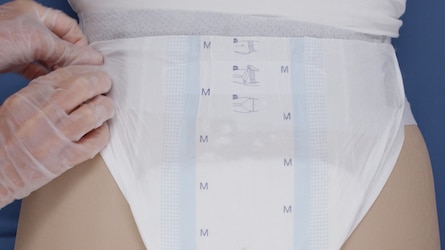This makes it easier for residents to find the toilet at night. Use amber-coloured lights to help minimize sleep disturbance. Also try light motion sensors that turn on automatically.
Toileting support for residents with incontinence
Dos
*Required fields

Leave the toilet door open and lights on at night
*Required fields

Mark toilet door, highlight toilet seats and light switch
Marking the toilet door and using contrasting colours can make it easier for residents to identify the toilet, light switch and toilet seat. A raised toilet chair or handrails improve positioning, making toileting safer and more comfortable.
*Required fields

Pay special attention to signs that a resident needs to use the toilet
This is particularly important when caring for individuals with any cognitive impairment as they may not be able to recognise the signals from the bladder or bowel or know what to do when they need to go.
*Required fields

Clothing that is easy to take off and put on helps avoid accidents
Some residents may have impaired mobility or dexterity. So, clothing that is easy to take off and put on can help avoid accidents. If incontinence products are required, pants are a good choice to facilitate toileting and maintain independence.
*Required fields

Keep the toilet clean, tidy and safe
Ensure the toilet area is kept clean, hygiene articles are kept within reach, and that residents can easily call for assistance if needed.
*Required fields

Praise residents and remain positive
It can be difficult for individuals to accept that they need help with toileting. So offer praise and always remain positive. Promote dignity by providing privacy and making residents feel comfortable, in control and valued.
Don'ts
*Required fields

Never skip a scheduled toilet visit
This can increase the risk of residents having an accident, which can affect their sense of dignity and self-esteem. If an accident happens, say something reassuring like “anyone could have an accident, I'll help you”.
*Required fields

Don’t only help with toileting at set times
Regular routines are good, but you should also be flexible and make sure assistance is available when needed. Always look for signs that they may need to go throughout the day. Most people need to go to the toilet 4-8 times during daytime, and sometimes at night if they are over 60. An average toileting schedule includes visits on waking up in the morning, after breakfast, around lunchtime, in the afternoon, in the evening and before bed.
*Required fields

Never replace toilet visits with incontinence products
Incontinence products should never replace a toilet visit. Keep encouraging your residents and help them to the toilet when needed. If they need incontinence products, choose an individually suited product type in the right size and absorbency level, and make sure it’s attached securely to avoid discomfort and skin chafing as well as to prevent leakages.
More tips for emptying the bladder
- Don’t rush. Residents may have difficulty urinating, so will need more time to make sure their bladder is completely empty. They may also need to change position a couple of times. So always be patient and help them stay calm and relaxed.
- The right sitting position can help empty the bladder. Help your residents find a good sitting position that supports their feet and lets them safely lean forward.
- Help residents stand up and sit down a couple of times to help with any difficulties emptying the bladder – this is known as double or triple voiding.
- If the resident is frail or thin, a soft pillow-ring can make the toilet seat more comfortable.


More tips for emptying the bladder
- Don’t rush. Residents may have difficulty urinating, so will need more time to make sure their bladder is completely empty. They may also need to change position a couple of times. So always be patient and help them stay calm and relaxed.
- The right sitting position can help empty the bladder. Help your residents find a good sitting position that supports their feet and lets them safely lean forward.
- Help residents stand up and sit down a couple of times to help with any difficulties emptying the bladder – this is known as double or triple voiding.
- If the resident is frail or thin, a soft pillow-ring can make the toilet seat more comfortable.




